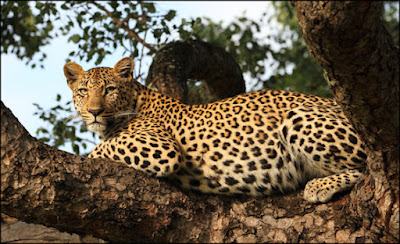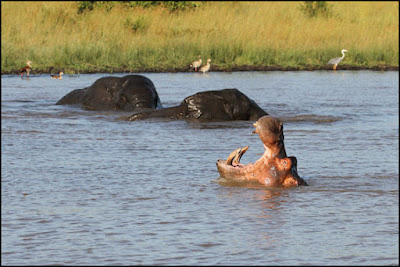It has been an eventful couple of months; The Mapogo Coalition has been forced out of the Western sector of the reserve. Sataan was killed by the Southern Males. The two ousted surviving Mapogo brothers have been seen to the east, they have temporarily taken up residence between the two existing coalitions. Southern and Machingalane which both consist of four males. It’s only a matter of time before they will be forced from this area. Recently they have taken up residence in the in the southern part of the reserve.
Click this link to see the lion fight between Sataan and the Southern Males. Warning Graphic Viewing. http://youtu.be/n7Sq-SJmd5Y
The southern pride males have been covering large distances. The new males are roaring on a regular basis and are trying to establish themselves in the area.
They continue to trail the large herds of buffalo and frequently try to hunt the large herbivores. The males killed a large male buffalo along the sand River.
The Ximungwe females have been keeping a low profile, and have been mostly to the east. Their cubs are still alive.
The three Ottawa females have been seen together and the mother of the four cubs is not showing signs of lactating anymore. We suspect that the new male coalition may have killed the cubs. This is normal behaviour when there is a change of ownership.
The Southern males have been mating with the Ottawa females, hopefully in a few months we will have some additional members of the pride.
The leopard viewing has been outstanding with both of the dominant males mating with various females. Kashane has been mating with Xicavi and Hlabankunzi and the Day One male with the Dam Three female and Hlabankunzi.
Click this link to see Day One and Hlabankunzi mating. http://youtu.be/rKRtQwuA9eE
Kashane has been seen with a recent impala kill which was hoisted high into a Jackal berry tree.
Shangwa’s male cub is growing rapidly and is seen regularly north of the Sand River.
The Ravenscourt female has two cubs at present which are to the east of our section. She has recently been more often than usual.
The Metsi female is showing signs of carry cubs, she was mating with the Day One male and this could be his first offspring as a dominant male.
Tlangisa has moved slightly further east and is almost seen on a daily basis. She hasn’t lost her interest in climbing trees and is constantly using the elevated advantage in scouting for suitable prey.
The Tassel berry female is seen close to the camp and on one occasion she strolled through the middle of the camp. She has become more relaxed and has settled in the southern section near Savanna. She has been mating with the Kashane male and may have her first litter soon.
A new male leopard has been seen close to Savanna, he comes from the Eastern side of the reserve. He is known as the Mashabene young male.
We have a resident African Wild Cat which lives close to the camp, although its looks like a domestic tabby cat there are some subtle differences.
Large breeding herds of elephants are encountered with young calves. We watched them crossing the Sand River.
We were very fortunate to see elephants mating, when we encountered them and they were quite relaxed.
Large herds of buffalo are encountered near the camp. The young calves which were recently born are growing quickly. There is an endless supply of ticks which has a symbiotic relationship between the buffalo and Red-billed Oxpeckers. The birds have a constant supply of ticks which in turn eradicates some of the parasites from the buffalos. Some of the buffalo have been photographed with up to 15 birds on their backs.
Click this link to see a new born calf taking its first steps. http://youtu.be/3DQW9RtmtJs
A large clan of Spotted Hyenas chased Kashane off of an impala kill. The ten animals wasted no time in devouring the carcass. The hyena numbers are on the increase at present.
The packs of wild dogs are doing well with and alpha and beta females showing signs of carrying offspring. Under normal circumstances only the alpha female would have a litter. The only surviving pup from the previous litter came from the original alpha female who died last year. The beta female assumed the role of the alpha female; however the current beta female which was the original alpha female pup is showing signs of being dominant over the current alpha female. It is certainly interesting to see what develops over the coming months. They should be denning in the next few months.
The general game has been good with giraffe, zebra and warthog sightings. The warthogs were eating buffalo dung that was deposited on the road. Minerals are obtained from the dung. Various predators will also roll in elephant, buffalo and rhino dung. This is to mask their scent and enable them to get closer to their prey without being detected.
Hippo sightings have been good. We have a resident male and female living in George’s Dam. He is quite a show off, with large yawnshe attempts to intimidate any animal that approaches the water, however this doesn’t necessarily work with elephants.
The rhino Sightings have been good, as the mud wallows dry up going into winter they are seen close to more permanent water sources.
Most of the migrant birds have left to return to warmer climates these include the Woodland Kingfisher and the Southern Carmine Bee-eater.
The birdlife at this time of the year is still good. Raptors are seen perched in large trees. With the cool mornings the large birds wait for the thermals to form before soaring in search of food. A perched juvenile Martial Eagle and a flying female Bateleur.
We were treating to a great sighting of two different raptors perched closely together. Two Hooded vultures and an adult and juvenile Bateleurs are barely inches away from each other.
A very relaxed White Faced Owl perched on a dead tree.
A pair of Double Banded Sand grouses have been seen, these birds have returned for the winter months.
Two of the more common birds that are seen are the African Jacana and the Helmeted Guinea-fowl.
A bark spider definitely bit of more than it could chew with a large beetle caught in its web.




















































































No comments:
Post a Comment